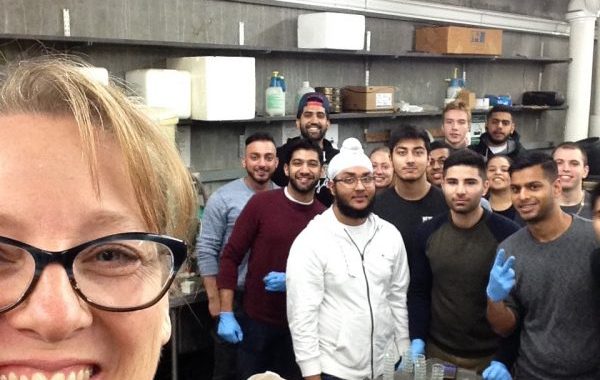The 2017 additions to the SENCER Model Series actively involve students in designing and carrying out projects as they master course concepts. Ecotoxicology, or the “Worm Lab” by Dr. Sharon Pochron of Stony Brook University, includes two courses, EHI 350: Design and Implement a Research Project in Ecotoxicology (fall) and EHI 351: Conduct and Communicate a Research Project in Ecotoxicology (spring). All projects have human angle: how dangerous is (fill in the blank with an environmental toxin) to soil and the creatures that live in soil? Students study existing literature, set up and run an experiment, and analyze results for publication and dissemination.
Field & Natural Science, a course for pre-service middle school teachers, models effective pedagogical methods that the students can later use in their own practice. Students participate in fieldwork surrounding environmental issues, collect and analyze data, and share results. Dr. Sarah Haines of Towson University focuses improving pre-service teacher education in environmental issues, and has been a leader in the SENCER community in this work. She is a SENCER Leadership Fellow and is currently part of a grant project through NCSCE and the Institute of Museum and Library Services to develop partnerships between colleges, universities, and informal education venues.
Ecotoxicology (“Worm Lab”), Dr. Sharon Pochron, Stony Brook University
By its nature, ecotoxicology pulls in policy and culture. For instance, it was the WHO that reclassified Roundup’s main ingredient as a probable toxin, and it is school districts across Long Island, the US and Europe who are pulling out grass fields and replacing them with fields made of recycled tires.
The first semester begins by articulating the environmental toxins that currently concern the students. Students then perform an extensive review of published literature regarding their toxin using Web of Science, Google Scholar and/or PubMed. After reading the literature, students walk through what we know and don’t know about the risks associated with the toxin, and devise a way to test the risk using earthworms and soil microbes. At this point, sample size issues, costs, and how to interpret various outcomes are discussed. If the students want to use techniques that Dr. Pochron doesn’t personally have in her toolkit, Dr. Pochron and the students discuss ways to get access to them. This has led to teaming with chemistry professors, ecotox labs, and Brookhaven National Laboratories. Over the course of two semesters, at least one research project is conducted, sometimes two or more, the paper is written, and the Spring students present their research at SBU’s science fair. After they get the project underway, the Fall students draft high-quality Introduction and Methods sections for their research. The Spring students complete the research and writing. In the Spring semester, effective ways and venues for communicating findings are discussed, thereby engaging local citizens in science in general and this research in particular. Access the full model here.
Field & Natural Science, Dr. Sarah Haines, Towson University
Field & Natural Science is a 300-level course taken by middle school education majors and those majoring in environmental science and studies under the informal environmental education track. The course is taught in a pedagogical modeling format, meaning the course instructors deliver the course content by modeling pedagogical methods that they would expect the students to follow when they become teachers. The course meets once a week for three hours, a format that allows time for field investigations to be completed on and around campus.
Active learning is expected of all students. Throughout all activities, students work collaboratively to organize concepts and ideas. Students take responsibility for designing their own investigations around driving questions that the instructor poses. Data collection and analysis are completed in small groups. Students actively participate in a variety of field-based investigations and activities taken from Project WILD, Project WET, and project Learning Tree – K-12 environmental education curricula that emphasize in classroom and outdoor activities promoting content knowledge and awareness of issues surrounding wildlife, water conservation, and plants and trees. Students learn how to integrate civic engagement and service-learning into their classrooms while teaching middle grades students about these topics.
Through schoolyard investigations focusing on water quality, habitat availability, soil science, and human impact, students learn how to conduct a schoolyard habitat assessment with students that will lead to an environmental action project appropriate for middle grades students to complete on school grounds or in their communities. In order to effectively carry out this project, students must master the environmental science behind the action project. They must also know the most appropriate and effective methods of teaching the content and skills to their middle grades students. Access the full model here.
Photograph of Sharon Pochron and students in the Worm Lab courtesy of Sharon Pochron

